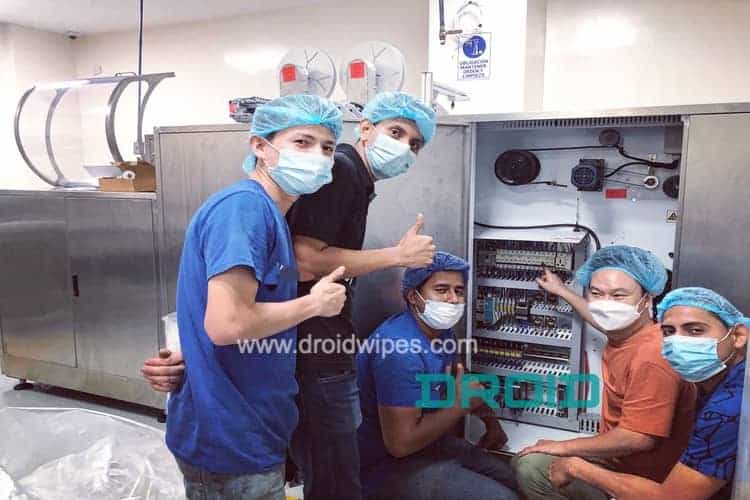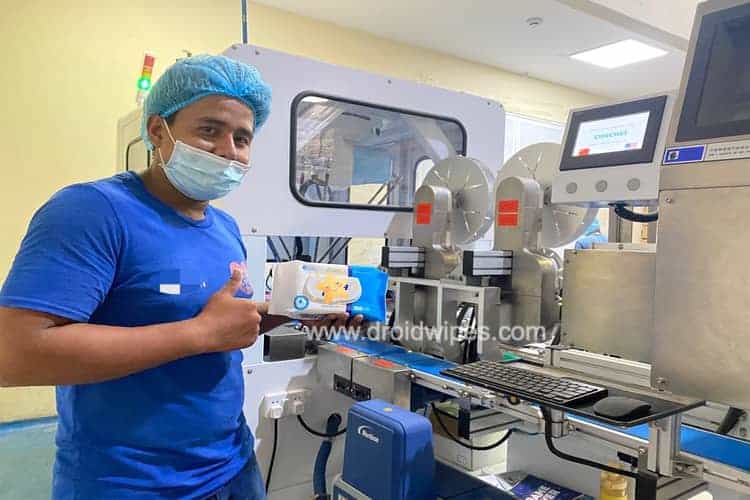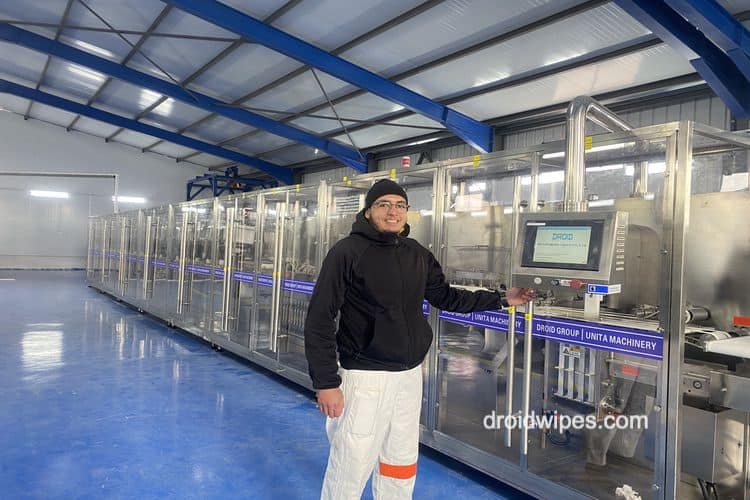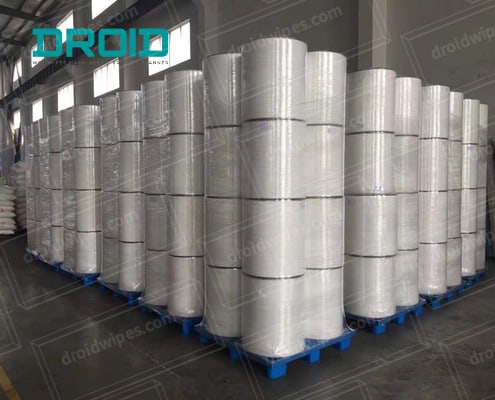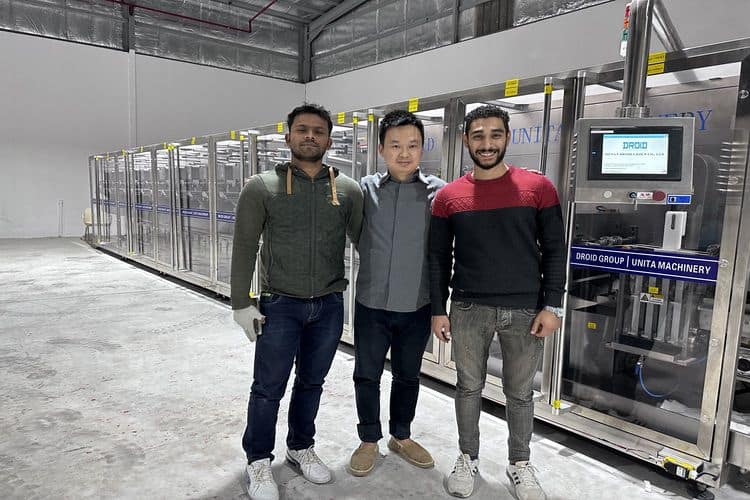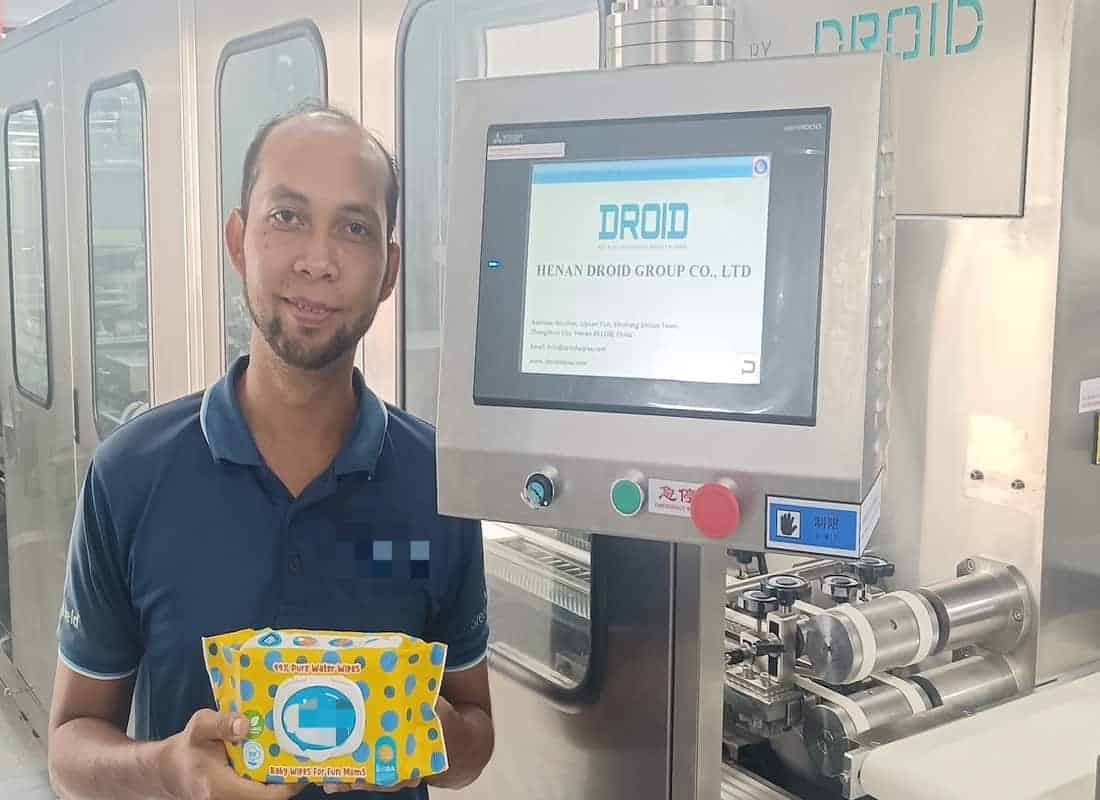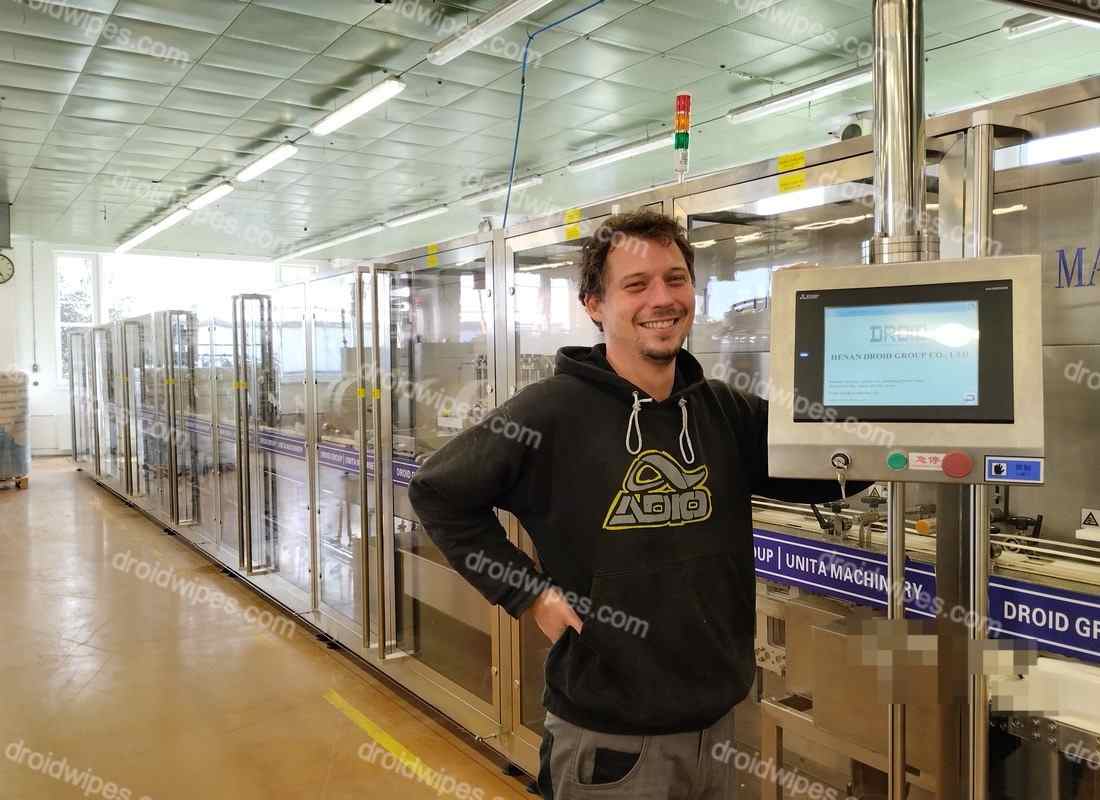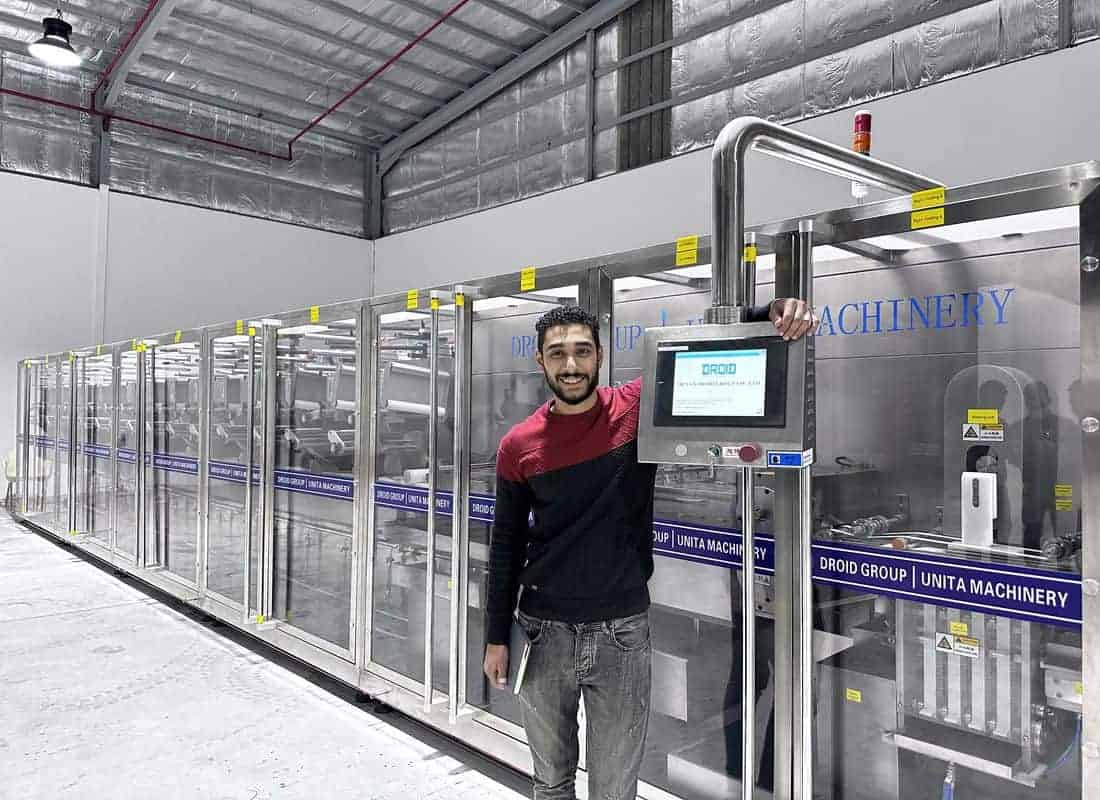1. Understand the Machinery Inside Out
Any manufacturing process revolves around its operators, and the key to achieving peak performance is having a thorough grasp of the machinery they operate. Wet wipes machine operators should have a comprehensive understanding of the design, capabilities, and limits of their machine rather than only adhering to standard operating protocols. In addition to giving operators more confidence, this knowledge enables them to optimize productivity and avert expensive problems before they start.
Studying technical manuals and user guides in-depth is the first step towards building a solid foundation. These resources include operating principles, component operations, and maintenance advice. But true mastery is more than just reading. It is essential to get practical instruction from technical specialists or machine makers. Practical lessons provide important insights into complex topics that manuals alone cannot adequately explain, such as automated controls, sensor integration, and precise calibration.
Early warning indicators like odd sounds, sudden vibrations, or changes in cut quality may be picked up by operators who are familiar with their equipment. They may save downtime and expensive repairs by taking prompt action, such as realigning a malfunctioning blade.
Additionally, understanding the subtleties of the equipment enables operators to better adapt it to various production requirements. Making well-informed modifications ensures the machine operates at maximum efficiency without sacrificing product quality, whether that means adjusting speed for fragile nonwovens or fine-tuning folding patterns.
Ultimately, operators with a thorough understanding of the machine can troubleshoot efficiently, maintain consistent quality, and contribute to making production more efficient. This proactive strategy is essential for maintaining competitiveness and achieving long-term success in the manufacturing of wet wipes.
2. Master Preventive Maintenance Techniques
The foundation of keeping wet wipes machines in top shape and performing at their best over time is preventive maintenance. Proactive maintenance prolongs component lifetime, minimizes unplanned downtime, and prevents minor problems from becoming expensive failures.
A well-planned schedule that is broken down into daily, weekly, and monthly chores is the first step towards effective preventative maintenance. Cleaning surfaces, checking moving components for noticeable wear, and making sure they are properly lubricated are a few examples of daily inspections. Adjusting folding or cutting mechanisms, confirming sensor accuracy, and monitoring belt tension are examples of weekly procedures. More extensive inspections, automatic system calibrations, and the replacement of damaged components are often included in monthly duties.
A key component of this approach is early issue identification. Operators should be on the lookout for warning indicators such as odd sounds, uneven folds, or varying speeds. Uneven folding, for instance, might be a sign of a misalignment that has to be fixed right away to prevent downtime and material loss.
Another important component is documentation. All maintenance actions, including component replacements, calibrations, and any problems detected, should be meticulously documented by operators. These documents are an invaluable resource for identifying recurring issues and enhancing future maintenance schedules.
Working together is also essential. To exchange ideas, discuss results, and improve best practices, operators should maintain constant contact with supervisors and maintenance teams. This collaboration ensures a shared understanding of machine performance objectives and helps resolve minor issues before they escalate into more serious problems.
Finally, it’s critical to stay up-to-date with the latest maintenance methods and equipment. Attending seminars or training sessions helps operators maintain high standards of care while adapting to new technology.
Preventive maintenance-trained operators not only ensure production continuity but also promote long-term cost savings and operational effectiveness. A well-maintained equipment is a dependable partner for long-term success in the wet wipes production industry.
3. Monitor and Calibrate Regularly
In the manufacturing of wet wipes, regular calibration and monitoring are essential for preserving peak performance, reducing waste, and guaranteeing constant product quality. Monitoring is keeping a close eye on important machine factors, including alignment, pressure, speed, and temperature. Even though contemporary machines often include sophisticated sensors and real-time diagnostics, trained operators are still necessary to identify minute problems that automated systems can overlook. A decrease in cutting pressure, for instance, may result in uneven wiping, which would increase waste and lower quality. Visual examinations of sealed packets and folded wipes may also aid in the early detection of such flaws.
Contrarily, calibration guarantees that machine parts remain properly tuned to provide reliable outputs. Variations from ideal settings may occur over time due to wear, ambient influences, and material changes. These changes are corrected by routine calibration, ensuring precision in operations like cutting, folding, and applying glue. For example, adjusting the folding mechanism guarantees consistent folds, and recalibrating cutting instruments helps avoid jagged edges. Adhesive dispenser calibration ensures correct application, preventing overuse and underuse that might compromise product integrity.
To confirm performance parameters, operators should utilize diagnostic tools and a systematic calibration program. Maintaining thorough records of modifications and patterns encourages preventive maintenance and aids in identifying persistent problems. For intricate recalibrations, collaborating with technical experts ensures that even sophisticated systems, including automation modules and precision sensors, function faultlessly.
Regular calibration and monitoring increase machine dependability, minimize downtime, and optimize material use. By maintaining equipment within its ideal specifications, manufacturers can save expenses, decrease product rejections, and reliably satisfy customer expectations. When strictly adhered to, these procedures ensure the highest levels of quality and dependability in the manufacture of wet wipes, while also increasing production efficiency.
4. Optimize Machine Speed for Material Types
In the manufacture of wet wipes, maximizing machine speed according to material type is essential for preserving product quality, reducing waste, and guaranteeing effective production. Under varied working speeds, different materials—like biodegradable textiles, textured surfaces, or synthetic blends—react in various ways. Operators must modify machine speed to correspond with the distinct properties of each material to achieve the ideal balance between performance and productivity.
For instance, since biodegradable fabrics are usually more sensitive than synthetic materials, slower rates are sometimes needed to avoid ripping or damage. On the other hand, synthetic or reinforced materials may tolerate greater speeds, enabling quicker manufacturing without sacrificing quality. Operators may adjust settings and prevent needless flaws by being aware of these variations.
Changing the pace also guarantees that other operations, including cutting, folding, and applying lotion, continue to be coordinated. Working too quickly with delicate fabrics might result in uneven folds or sharp edges, which affect both beauty and functionality. On the other hand, operating sturdy materials too slowly lowers efficiency and raises expenses per unit.
The speed of the machine also influences the absorption of lotions or adhesives. Various materials absorb solutions in different ways, and oversaturation or uneven distribution may result from incorrect speed settings. Proper absorption and consistent product performance are ensured by gradually slowing down the machine during the application phase.
Experimentation and ongoing data analysis are often necessary for speed optimization. By utilizing real-time data analytics from sophisticated equipment, operators can test and adjust speed settings for new materials to monitor their impact on output quality and performance.
Operators may increase output while decreasing waste and errors by adjusting machine speed to certain materials. In addition to increasing production efficiency, this meticulous modification guarantees that clients will obtain premium wet wipes that meet their requirements. For best results, speed, accuracy, and material compatibility must be balanced.
5. Leverage Real-Time Data Analytics
An effective method for operators to improve wet wipes machine performance, efficiency, and product quality is to utilize real-time data analytics. Modern machines incorporate integrated software and sophisticated sensors that continuously gather and analyze production data. By providing practical insights, this data enables operators to take proactive measures to resolve issues and make informed decisions.
Operators may keep an eye on key performance indicators (KPIs), including production speed, energy consumption, material use, and downtime frequency, using real-time analytics. For instance, operators may promptly look into possible reasons, such as misalignment, inaccurate cutting, or inconsistent material, and take timely remedial action if data shows an increase in material waste during a particular batch. This prompt action cuts down on expenses, delays, and resource waste.
The predictive power of real-time analytics is a major benefit. Predictive maintenance systems that examine patterns in sensor data to spot wear or possible problems early are often a feature of sophisticated machinery. For example, a sensor’s detection of increased vibration can suggest that a component needs to be replaced or lubricated. Early detection of these indicators reduces the likelihood of unplanned malfunctions and expensive downtime.
Continuous optimization is also supported by data analytics. Operators can enhance product quality and reduce material waste by fine-tuning machine settings, such as pressure or speed, by examining patterns. These data-driven changes eventually result in increased operational efficiency and consistency.
Additionally, real-time data enables supervisors and operators to work together more effectively. Analytics insights ensure that decisions align with long-term performance objectives by providing verifiable evidence to support requests for additional training, process improvements, or resources.
Lastly, real-time data enhances traceability and accountability. Operators can maintain quality standards, ensure regulatory compliance, and take prompt remedial action by pinpointing the precise location of variations.
Operators transition from reactive to proactive machine management by leveraging real-time data analytics, which boosts productivity, reduces waste, and ensures consistent product quality in today’s competitive market.
6. Ensure Proper Material Handling
For wet wipes machines to operate efficiently and guarantee constant product quality, proper material handling is essential. From fabric rolls and adhesives to lotions and packaging materials, the types of materials used have a direct impact on the functionality and dependability of the equipment. To prevent damage, reduce waste, and ensure seamless operations, operators must follow best practices when checking, storing, and loading supplies.
The first stage is a comprehensive inspection. When supplies are received, operators should carefully inspect them for flaws like ripped rolls of cloth, uneven edges, or contamination in lotions and adhesives. Major problems like machine jams or inconsistent product quality may result from even minor defects. A ripped roll of fabric, for instance, may catch within the machine and result in delays and material loss. Early detection and resolution of these problems guarantees that only high-quality inputs are used in manufacturing.
Equally vital are appropriate storage conditions. Biodegradable textiles and adhesives are among the many materials that are susceptible to changes in light, humidity, and temperature. To avoid moisture absorption that weakens fibers and causes ripping, operators should keep cloth rolls in clean, dry locations. To preserve their effectiveness and consistency, adhesives and lotions need to be stored at the proper temperature.
Proper tension and alignment are essential while putting materials into the machine. Uneven cuts or folds may result from misaligned rolls, and stretching or wrinkles can be caused by incorrect tension, both of which reduce product quality and increase waste. To avoid these issues, operators should always utilize the tension control systems and guidance that the machine provides.
During manufacturing, regular monitoring is also crucial. To prevent jams, misaligned seals, or overapplication that might affect performance, operators should ensure that adhesives are applied uniformly and packing materials are supplied appropriately.
Material management is further strengthened by cooperation with procurement teams. Operators contribute to ensuring that suppliers continuously provide high-quality materials appropriate for effective production by exchanging input on material performance.
Operators may save waste, avoid downtime, and reliably create high-quality wet wipes by emphasizing appropriate material handling, which will increase productivity, cut expenses, and improve customer satisfaction.
7. Communicate and Collaborate
To ensure smooth, efficient production and maximize the efficiency of wet wipes machines, effective collaboration and communication are crucial. Because they may discover irregularities and chances for improvement before they become serious, operators are often the first line of defense. To promote proactive problem-solving and ongoing development, operators encourage open communication with technicians, managers, and other team members.
Operators are crucial in quickly alerting supervisors or maintenance teams to equipment issues, such as unusual sounds, poor product quality, or sensor alerts. Timely reporting prevents minor problems from escalating into catastrophic breakdowns. For instance, if a technician is informed promptly by an operator about uneven folding, changes can be made promptly, reducing waste and upholding product standards.
Reactive problem-solving is just one aspect of collaboration. Operators should contribute actively to team conversations by offering their practical experience-based views. Better maintenance plans, enhanced machine settings, and even process innovations may result from this cooperative input. For example, collaborating with engineers may lead to adjusting speed settings for smoother performance if an operator observes frequent clogs at specific rates.
Maintaining constant contact with supervisors helps coordinate daily tasks with broader production objectives. Supervisors can prioritize maintenance tasks and adjust production schedules in real-time based on operator input, ensuring that both short-term goals and long-term efficiency objectives are met.
Developing a solid rapport with technicians is similarly crucial. Operators’ precise, in-depth observations facilitate quicker diagnosis and repairs while fostering mutual respect and confidence across teams. Collaboration is further improved by cross-training; technicians may teach operators sophisticated troubleshooting skills, while operators educated in basic maintenance can help technicians. The workforce becomes more robust and adaptable as a result of this information sharing.
It’s also critical to communicate effectively with other partners, including material suppliers. Providing suppliers with thorough feedback helps resolve persistent problems and bring them into compliance with production standards.
Operators create a unified, problem-solving workplace by emphasizing effective communication and teamwork. This collaboration ensures excellent product quality, reduced downtime, and lower operating costs in the manufacture of wet wipes, where accuracy and reliability are crucial.
8. Conduct Mock Emergency Drills
Mock emergency drills are a beneficial but sometimes disregarded method of guaranteeing operational preparedness in the manufacturing of wet wipes. These exercises equip operators to react quickly and assuredly to unforeseen disturbances like software bugs, machine failures, power outages, or material bottlenecks. Operators develop the abilities and muscle memory required to handle actual situations while reducing production downtime and safeguarding equipment via lifelike simulations.
Operators become familiar with crucial emergency shutdown and recovery protocols through mock exercises. For instance, operators may practice properly halting equipment, securing supplies, and restarting systems once power is restored during a simulated power outage. In a similar vein, learning how to clear material jams helps workers remove obstacles safely and effectively, lowering the possibility of human harm or equipment damage.
These exercises also draw attention to any holes or flaws in the procedures that are in place. Uncertain instructions, a lack of tools, or team member training shortages are often exposed via simulations. Proactively addressing these problems improves overall readiness and adjusts processes to meet the particular requirements of the manufacturing line. For example, a drill may reveal that novice operators need more instruction on how to handle specific machine issues.
Improved cooperation and communication between operators, technicians, and supervisors are fostered via mock exercises. Coordinated activities are necessary for emergency responses, and role-assignment and experience cooperating under duress are two essential benefits of simulations. For instance, without misunderstanding or delay, a technician analyzes the issue while another operator gets tools and shuts down the machine.
Frequent drills also lower the risk of accidents and increase safety compliance. When under stress, operators who are acquainted with emergency shutdown procedures are less likely to make crucial mistakes, protecting the equipment and themselves.
Recording every practice, including reaction times, protocol modifications, and lessons learned, guarantees ongoing development and acts as a training tool for later use.
Regular training that incorporates simulated emergency drills enhances operator confidence and strengthens production resilience. Teams are empowered by this proactive approach to confidently and effectively adhere to safety standards, safeguard equipment, and maintain continuous operations.
9. Embrace Advanced Operator Training
To remain competitive in today’s increasingly complex wet wipes manufacturing sector, improved operator training is crucial. To properly manage, maintain, and optimize these complex systems, operators must continually enhance their skills as machines become increasingly automated and integrated with technologies such as AI and IoT.
Current wet wipers include sophisticated features, including sensors for predictive maintenance, real-time analytics, and software interfaces that may be customized. It takes more than just fundamental operational expertise to comprehend and use these technologies effectively. Operators gain the ability to analyze data, spot patterns, and make well-informed modifications to increase productivity and product quality via advanced training. Analytics dashboards, for instance, may be used in real time by a skilled operator to improve consistency or cut waste.
Operators with advanced training are also more prepared to tackle challenging troubleshooting jobs. Competent operators can rapidly and precisely identify problems using diagnostic tools rather than depending on trial-and-error techniques. Operators who get predictive maintenance training are even more equipped to respond to early warning indicators and avoid expensive downtime.
Advanced training also promotes process optimization. Operators may alter speed, pressure, or folding patterns to suit new materials or enhance product results by having a thorough grasp of machine mechanics and software. This is particularly helpful when expanding production or introducing new items.
Advanced training enables operators to adapt to emerging technologies, such as AI-driven automation and remote monitoring, by exposing them to industry developments that extend beyond technical capabilities. Additionally, it encourages operators to propose ideas and actively contribute to operational efficiency, fostering a culture of continuous development.
Lastly, investing in advanced training increases operator involvement and confidence. Skilled operators are more flexible, driven, and able to sustain a robust and creative production environment.
Manufacturers that use advanced training make sure that operators are prepared to optimize machine performance, reduce downtime, and promote long-term success, which leads to better goods and a more powerful competitive advantage.
10. Focus on Energy Efficiency
Energy efficiency in the manufacturing of wet wipes is essential for cutting expenses, lessening the effect on the environment, and advancing sustainability objectives in general. Operators may achieve substantial savings while maintaining excellent machine performance by using energy-efficient methods, as energy costs often account for a significant portion of production costs. Beyond price, energy efficiency satisfies customers need for more environmentally friendly production.
Making use of integrated energy-saving features is one such tactic. Eco-mode settings on a lot of contemporary wet wipes reduce energy use without sacrificing quality. These modes should be engaged by operators, particularly in smaller production runs. For instance, energy consumption may be significantly reduced by lowering machine speed while creating smaller quantities.
Additionally, regular maintenance is essential. Because of wear, misaligned parts, and friction, poorly maintained machines use more energy. To avoid needless energy waste, operators should make sure belts, motors, and moving components are correctly greased and calibrated.
Another good strategy is to cut down on idle time. Energy is wasted and expenses are increased when machines are kept running during breaks. During prolonged downtime, operators should make it a practice to turn off their equipment. Programmable logic controllers (PLCs) in automated lines may assist by automatically shutting down equipment after extended periods of idleness.
Real-time energy usage monitoring enables operators to identify inefficiencies. By modifying machine settings or exploring alternative configurations through data analysis, operators can optimize efficiency.
Energy usage is also affected by the choice of material. It often takes less energy to cut, fold, and seal materials that are lighter or thinner. To prevent additional energy demands, operators should collaborate with procurement teams to choose materials that strike a balance between quality and energy efficiency. They should also make sure that the alignment and tension are correct.
Further cost savings and a reduction in grid demand are achieved by scheduling output during off-peak energy hours.
Operators can create a more economical and environmentally friendly manufacturing process by fostering an energy-conscious culture and implementing basic procedures, such as combining production cycles or shutting off lights in unused areas. Making energy efficiency a top priority improves operational performance, lowers costs, and positions manufacturers to meet international sustainability criteria.
11. Perform Daily End-of-Shift Inspections
Maintaining the effectiveness, dependability, and lifespan of wet wipe machines requires regular end-of-shift checks. Operators can minimize expensive downtime and ensure that machines are prepared for the next production cycle by spending a few minutes to examine the equipment after each shift.
A comprehensive visual examination of crucial parts should be the first step in any inspection. Operators should keep an eye out for worn belts, loose fasteners, and frayed wires as indicators of wear. For example, detecting a slightly misaligned cutting blade might save time and resources in the subsequent batch by preventing uneven cuts.
Another crucial stage is cleaning. Surfaces, sensors, and moving components may accumulate material, adhesive, or lubrication residue throughout the day. Proper cleaning prevents this accumulation from affecting machine operation, ensuring consistent product quality and minimizing unnecessary wear.
Lubrication needs to be checked and refilled. Parts that are well-lubricated, particularly folding mechanisms, cutting blades, and rollers, prolong part life, reduce friction, and use less energy. Smooth functioning in the next cycle is ensured by addressing these areas after each shift.
Documentation is just as crucial. Operators should document the results of their inspections, the steps they took, and any parts that need further care. In addition to providing information for the next shift, this record aids in preventive maintenance planning and the long-term tracking of recurring problems.
It’s crucial to communicate clearly with new team members and managers. Operators can lower the chance of missed issues by fostering a culture of responsibility and cooperation through open communication of inspection findings and any urgent concerns.
Operators who conduct routine end-of-shift inspections gain a deeper understanding of machine behavior and are better equipped to identify subtle changes. This proactive approach supports high product standards, preserves production timelines, and enhances overall process dependability.
Manufacturers protect equipment functionality and guarantee seamless, continuous wet wipes manufacturing by including comprehensive daily inspections into ordinary operations.


